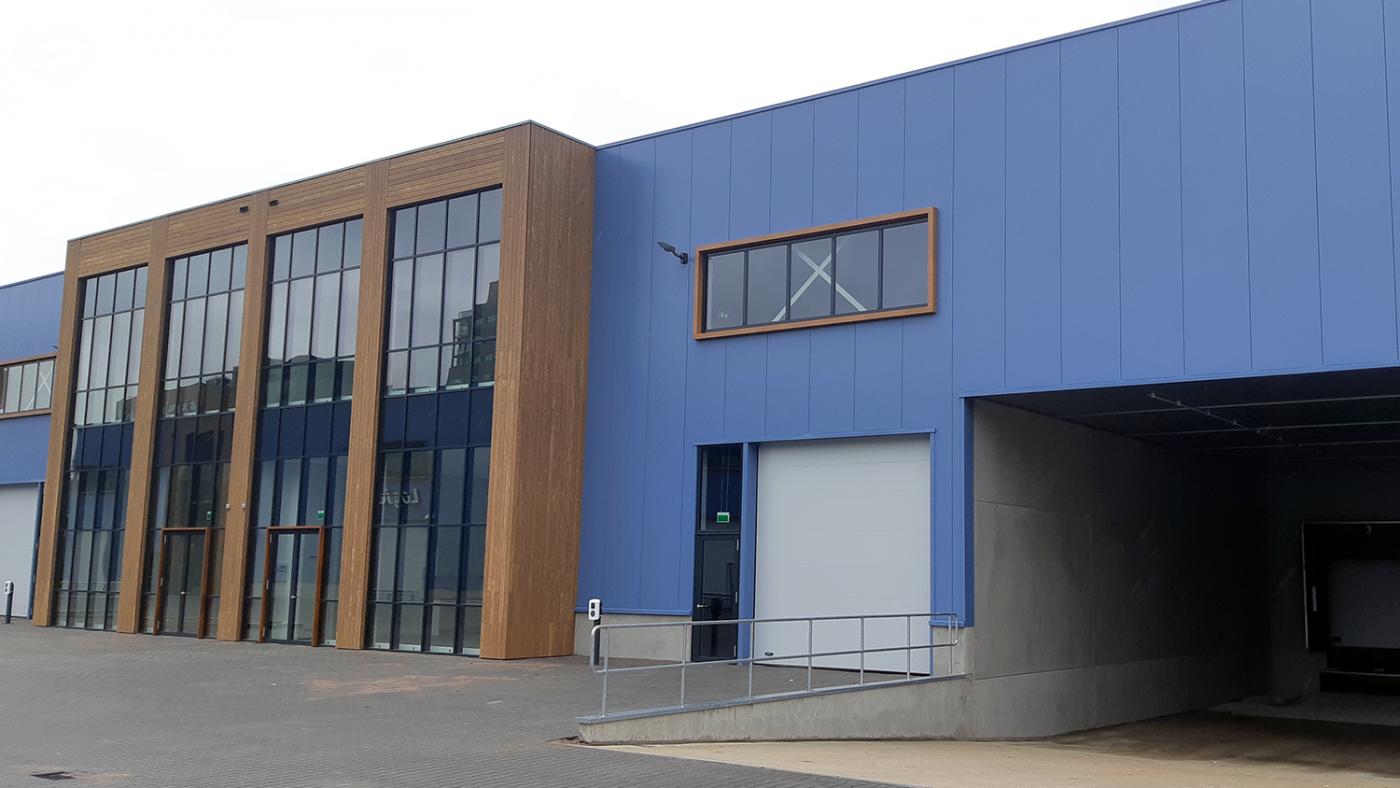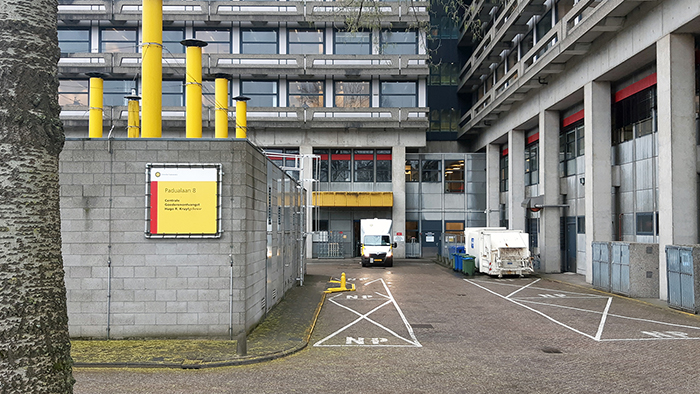From now on, mail and packages to go through new warehouse in Kanaleneiland

Approximately 1,000 square meters in size, the new location at Winthontlaan 30 C is almost three times the size of the current warehouse in the Kruyt building. Part of the warehouse and the office space in Kanaleneiland will be sublet to the Utrecht East Hub.
The hub is an initiative from the university in partnership with the province of Utrecht, the Utrecht University of Applied Sciences and various other companies and organisations based in the Utrecht Science Park and the Rijnsweerd region. These organisations will now also be asking suppliers to firstly make their deliveries at a central location like UU already did in the Kruyt building.
The new working method is supposed to contribute to reducing the number of cars circulating in the Utrecht Science Park, as foreseen in the long-term vision plan for the area. The document also envisages closing Leuvenlaan Avenue, the entranceway to the Kruyt building.
Transition manager Birgit Hendriks: "We no longer want freight trucks entering the Science Park, causing pollution and traffic jams. This will make the Science Park an even more pleasant area for students and employees to visit. Especially now that it’s becoming more and more of a residential area".
In addition, the university’s central goods delivery point and the hub would like to make the transport of goods in Eastern Utrecht emission-free by using electric vehicles. In the long run, the intention is to achieve a more integrated working method for UU's goods receipt and the hub. This can be done, for instance, by combining orders from organisations at the USP with joint suppliers and by combining the transport of goods from Kanaleneiland to the USP and Rijnsweerd. Transition manager Birgit Hendriks explains: "This enables us to become twice as sustainable."
Fossil free
But that’s still a long way off. The new location has been rented in April 2022. From May 9, packages addressed to UU can be delivered there. According to Birgit Hendriks, the transition will take place "step by step", so both locations will have work activities going on for some time.
The storage of hazardous goods like chemicals will stay at the Utrecht Science Park for the next few years, adds Hendriks. They will be stored in the "services building" next to Kruyt.
Currently, UU is using a van and two small trucks running on diesel. The lease of one of these trucks is ending soon and the other one will end in a few years' time.
Asked whether the commute of diesel-driven vehicles from the new location will lead to more pollution in the short term, Hendriks says: "The delivery trucks can now take their goods right next to the A12 motorway, so most of the time they make a shorter trip. Even if we only combine the goods of just two suppliers, and still use a diesel van, we will avoid driving a diesel truck to addresses in the Science Park."
The idea is to have the transport from Winthontlaan Avenue to the city-centre buildings and the Utrecht Science Park proceed entirely by electric and therefore emission-free vehicles — cargo bikes, for example. There will also be solar panels on the roof of the warehouse so the Hub and the central goods departments run "fossil-free".
Zero
Hendriks says that she cannot indicate how much CO2 emission will be saved thanks to this measure. Due to the pandemic, it was not possible to conduct an adequate baseline measurement. In addition, it is unclear to which extent the supply of goods is set to change, as employees continue to work from home often even after the peak of the pandemic. "It’s evident that fossil-free supply is going to be achieved, so this part of UU also meets the university’s sustainability ambitions."
According to Hendriks, measurements were carried out before the pandemic, in 2019. At that time, on an annual basis, about 50,000 packages and about 100,000 postal items were sent to the faculties. Approximately 225,000 items were sent out by order of the faculties. In addition, many of the package flows were still decentralised, i.e. do not proceed through the central goods department, going straight to the faculties instead. In the upcoming years, these flows will also increasingly be delivered through the new warehouse.

The central goods delivery point in the Kruyt building.
No cutbacks
The twelve employees of the mailroom and the central goods delivery point will keep doing the same work. Two employees will keep working in the Utrecht Science Park and everyone will remain employed by UU.
If the Utrecht East Hub turns out to be a success and enables the further integration of the various goods flows from Kanaleneiland to Utrecht Science Park and Rijnsweerd, in the long run, employees might be seconded, the Service Board of the University Administration Office has been told.
A short visit to the Kruyt building shows that the employees of the mailroom and central goods delivery point respond very differently to the intended plans. Some employees don’t have any problems with it, while others are happy because the new workplace is closer to home.
However, for other employees, the move from the Science Park comes as a shock, particularly for those who have been employed by the university for a long time. "We are being expelled from the village", one of them says. For two employees, the move — and the long-lasting uncertainty that comes along with it — was reason enough to quit UU.
Transition manager Hendriks acknowledges that the response to the news varies among employees, but, according to her, "in general, they are reacting positively". She emphasises that the decision to realise the new hub has nothing to do with cutbacks. Redundancies will not be considered until the Utrecht East Hub starts operating.
A more attractive prospect
The employees were not happy at all about an earlier suggestion to move the two departments to a location next to the Brothers disco in Bunnik, on the A12 motorway. They found the facilities there were dreadful, not to mention the location was hard to reach by public transport and the route leading to it was not considered safe. Ultimately, the negotiations between UU and the municipality of Bunnik didn’t result in anything.
According to transition manager Hendriks, the new building will be more to the liking of the employees, who were also invited to the key exchange. Now they’re organising themselves in working groups to prepare for the move. Hendriks: "This change offers many opportunities. It’s a gorgeous, easily accessible location. It’s also a completely new building that meets all requirements and wishes. Loading and unloading, for example, will be much more convenient. The team will also have an important say in the new working method, which is an attractive prospect for them".
Concerns regarding the Faculty of Science
UU stresses that the move should not affect the service to employees, who must be assured they will receive their ordered items correctly and on time. The Faculty of Science seems to be particularly concerned about this.
Earlier this year, faculty board member Suzan Ruijtenberg raised questions about the upcoming move after having noticed that the board of the biology department, where she works, wasn’t aware of what was going on.
Ruijtenberg says that, more than anything, there needs to be concrete information about the practical consequences of the move. According to her, there are great concerns regarding the supply of "critical" goods that are key for research, such as frozen animal DNA material and ice samples.
"We’re constantly told that those goods won’t be going to Kanaleneiland and that nothing will change. Well, we certainly hope not, but at the same time, that’s hard to believe. There are so many questions: who decides which goods are critical and which aren’t? What if a shipment contains critical and non-critical goods? Will they go to Kanaleneiland first?"
Furthermore, communication is faulty. Ruijtenberg regularly drops by the warehouse herself in the morning to pick up an order, so she can immediately start a new experiment. The faculty board member wonders what is going to happen when this flexibility and point of contact disappear. "Can I keep on counting on the same people at the central goods delivery room, for example? Or will there be new people who might not realise how important those materials are to us?"
Hendriks understands the feelings of the employees of the Faculty of Science. "They were lucky to be so close to the central goods delivery room. Other faculties do not have that history. Together with the faculty, we’re going to do all we can to ensure a service that is as optimal as possible. Just like we will for all the other employees".